
Glass Blowing for Vacuum Devices
Lamp Autopsy
I have found a way of dismantling a filament lamp in a controled way. This allows the
component parts to be examined in closer detail.
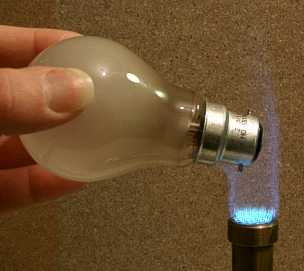 This is a standard 60W 240V incandescent lamp. The bayonet base of the lamp can be removed
by gently heating it. After a minute or two, the terminal solder melts and the cement
holding the base on softens. There is risk of the solder dripping off at this point and
getting it in the burner must be avoided.
This is a standard 60W 240V incandescent lamp. The bayonet base of the lamp can be removed
by gently heating it. After a minute or two, the terminal solder melts and the cement
holding the base on softens. There is risk of the solder dripping off at this point and
getting it in the burner must be avoided.
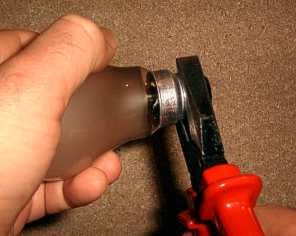 Once the solder has melted and the cement has softened, the base twists off quite easily
using a big pair of pliers. The cement in the base smells quite nasty after being heated.
Once the solder has melted and the cement has softened, the base twists off quite easily
using a big pair of pliers. The cement in the base smells quite nasty after being heated.
 This is the end of the lamp which was inside the bayonet base. The tube between the wires is
the pump stem. The lamp is safer to work on if it is first vented to atmospheric
pressure. To do this I scored the pump stem using the knife. The score mark shows up in
the photograph as the horizontal white line.
This is the end of the lamp which was inside the bayonet base. The tube between the wires is
the pump stem. The lamp is safer to work on if it is first vented to atmospheric
pressure. To do this I scored the pump stem using the knife. The score mark shows up in
the photograph as the horizontal white line.
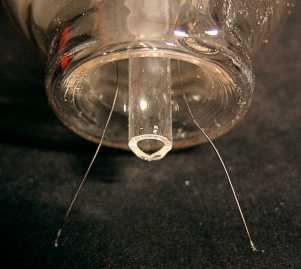 The end of the pump stem can then be knocked off by holding the side of the stem opposite the
scratch against the edge of the work surface and hitting the end of the stem with a hard
piece of wood (I use the back of the knife).
The end of the pump stem can then be knocked off by holding the side of the stem opposite the
scratch against the edge of the work surface and hitting the end of the stem with a hard
piece of wood (I use the back of the knife).
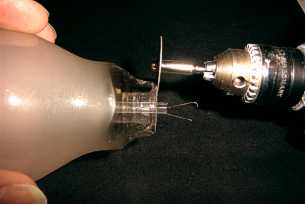 I ground the glass away around the base using a diamond wheel from
RS (stock number 182-887). I have found
that using the edge of the wheel causes too much vibration and cracks the glass. Using the
side of the wheel works much better.
I ground the glass away around the base using a diamond wheel from
RS (stock number 182-887). I have found
that using the edge of the wheel causes too much vibration and cracks the glass. Using the
side of the wheel works much better.
I used goggles and a mask to protect myself from the glass dust.
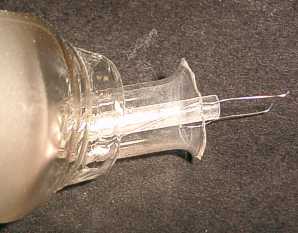 Finally, the bulb detaches. The filament support wires have to be squeezed together slightly
to remove the support structure from the bulb.
Finally, the bulb detaches. The filament support wires have to be squeezed together slightly
to remove the support structure from the bulb.
The filament support structure is shown in the photograph below. You can click on it for
an even bigger picture. The red Dumet seals can be seen clearly in the middle section.
These connect to the main support wires which supply current to the filament. There are also
two much finer filament supports which have no electrical function. They are probably made
of molybdenum. The small diameter inner tube on the right hand side is the pump stem which
was used to evacuate and gas fill the lamp during manufacture. An argon-nitrogen mixture
is normally used.
When a filament breaks in a gas filled lamp, an arc often starts. It can grow in a
fraction of a second until it bridges the entire filament. This causes a very heavy
current to flow. The lead-in wires on the right hand side are deliberately made thin
so that they act as fuses. Some lamps have more elaborate fuses.
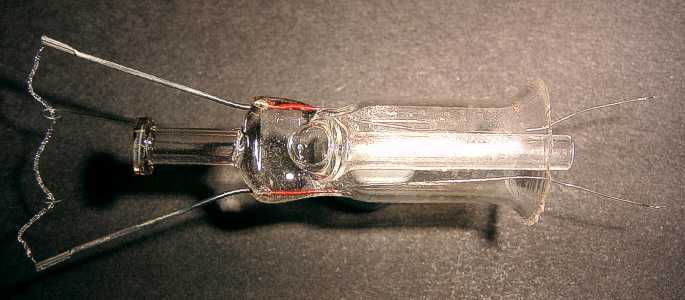
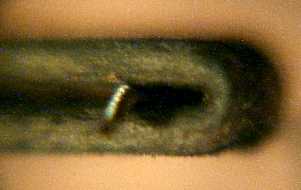 This is one of the crimped filament supports. The end of the filament can be seen pointing
out of the picture.
This is one of the crimped filament supports. The end of the filament can be seen pointing
out of the picture.
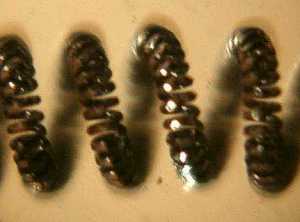 This is a section the tungsten filament at about 70 times magnification. At this
magnification, the coiled coil structure can be seen. There are about 22 small turns in
each big turn, each with a diameter of about 0.1mm. There are 35 outer turns per cm. The
outer turns are about 0.5mm in diameter.The filament is approximately 3cm long. There is
therefore about π x 0.0001 x 22 x 35 x 3 = 0.71m (28 inches) of wire in the filament.
This is a section the tungsten filament at about 70 times magnification. At this
magnification, the coiled coil structure can be seen. There are about 22 small turns in
each big turn, each with a diameter of about 0.1mm. There are 35 outer turns per cm. The
outer turns are about 0.5mm in diameter.The filament is approximately 3cm long. There is
therefore about π x 0.0001 x 22 x 35 x 3 = 0.71m (28 inches) of wire in the filament.
 This is a standard 60W 240V incandescent lamp. The bayonet base of the lamp can be removed
by gently heating it. After a minute or two, the terminal solder melts and the cement
holding the base on softens. There is risk of the solder dripping off at this point and
getting it in the burner must be avoided.
This is a standard 60W 240V incandescent lamp. The bayonet base of the lamp can be removed
by gently heating it. After a minute or two, the terminal solder melts and the cement
holding the base on softens. There is risk of the solder dripping off at this point and
getting it in the burner must be avoided.
 Once the solder has melted and the cement has softened, the base twists off quite easily
using a big pair of pliers. The cement in the base smells quite nasty after being heated.
Once the solder has melted and the cement has softened, the base twists off quite easily
using a big pair of pliers. The cement in the base smells quite nasty after being heated.
 This is the end of the lamp which was inside the bayonet base. The tube between the wires is
the pump stem. The lamp is safer to work on if it is first vented to atmospheric
pressure. To do this I scored the pump stem using the knife. The score mark shows up in
the photograph as the horizontal white line.
This is the end of the lamp which was inside the bayonet base. The tube between the wires is
the pump stem. The lamp is safer to work on if it is first vented to atmospheric
pressure. To do this I scored the pump stem using the knife. The score mark shows up in
the photograph as the horizontal white line. The end of the pump stem can then be knocked off by holding the side of the stem opposite the
scratch against the edge of the work surface and hitting the end of the stem with a hard
piece of wood (I use the back of the knife).
The end of the pump stem can then be knocked off by holding the side of the stem opposite the
scratch against the edge of the work surface and hitting the end of the stem with a hard
piece of wood (I use the back of the knife). I ground the glass away around the base using a diamond wheel from
I ground the glass away around the base using a diamond wheel from
 Finally, the bulb detaches. The filament support wires have to be squeezed together slightly
to remove the support structure from the bulb.
Finally, the bulb detaches. The filament support wires have to be squeezed together slightly
to remove the support structure from the bulb.
 This is one of the crimped filament supports. The end of the filament can be seen pointing
out of the picture.
This is one of the crimped filament supports. The end of the filament can be seen pointing
out of the picture. This is a section the tungsten filament at about 70 times magnification. At this
magnification, the coiled coil structure can be seen. There are about 22 small turns in
each big turn, each with a diameter of about 0.1mm. There are 35 outer turns per cm. The
outer turns are about 0.5mm in diameter.The filament is approximately 3cm long. There is
therefore about π x 0.0001 x 22 x 35 x 3 = 0.71m (28 inches) of wire in the filament.
This is a section the tungsten filament at about 70 times magnification. At this
magnification, the coiled coil structure can be seen. There are about 22 small turns in
each big turn, each with a diameter of about 0.1mm. There are 35 outer turns per cm. The
outer turns are about 0.5mm in diameter.The filament is approximately 3cm long. There is
therefore about π x 0.0001 x 22 x 35 x 3 = 0.71m (28 inches) of wire in the filament.